Heavy metal genres
A number of heavy metal genres have developed since the emergence of heavy metal (often shortened to metal) during the late 1960s and early 1970s. At times heavy metal genres may overlap or are difficult to distinguish, but they can be identified by a number of traits. They may differ in terms of: instrumentation, tempo, song structure, vocal style, lyrics, guitar playing style, drumming style, and so on.
Alternative metal
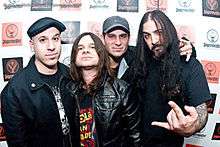
Alternative metal is a style of heavy metal and alternative rock which emerged in the mid-1980s, and gained popularity in the early 1990s.[1]
Alternative metal usually combines heavy metal with influences from genres like alternative rock, and in some cases other genres not normally associated with metal as well. Alternative metal bands are often characterized by heavy downtuned guitar riffs, melodic vocals, unconventional sounds within other heavy metal genres, unconventional song structures and sometimes experimental approaches to heavy music.[2] Many of the early alternative metal bands originated from Los Angeles.[3] Prominent bands in this genre include Alice in Chains,[4] Faith No More,[5] Helmet,[6] Life of Agony,[7] Rollins Band[3] and Tool.[3][8] More modern bands include Breaking Benjamin,[9] Chevelle,[10] Godsmack[11] and System of a Down.[12]
Derivatives of alternative metal
Funk metal
.jpg)
Funk metal is essentially a fusion of heavy metal and funk. It started off in the late eighties as a subgenre of alternative metal, and was heavily influenced by bands such as Red Hot Chili Peppers and Fishbone. During the late-'90s, many bands which started out as funk metal branched out into more commercially viable genres, such as alternative rock and nu metal. Notable funk metal bands include Living Colour, Infectious Grooves, Mordred, Primus, and Rage Against the Machine.[13] The biggest regional scene during funk metal's prime was San Francisco.[14]
Nu metal
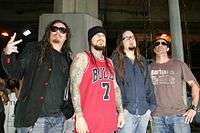
Nu metal is fusion genre that blends alternative metal and groove metal elements with other styles, including grunge, industrial, funk and hip hop. The style is mostly syncopated and based on riffs,[15] and is influenced by groove metal rhythm.[16] Some nu metal bands use seven-string guitars, which are sometimes down-tuned to increase heaviness, resulting in bass guitarists using five and six-string instruments.[17] Turntables, sequencers and samplers are sometimes included.[17] Nu metal vocal styles range between melodic singing, rapping, screaming and death growling. In 1994, Korn became the first band to be labeled as "nu metal".[18] Deftones,[19] Coal Chamber,[20] Linkin Park,[21] Slipknot,[22] Papa Roach,[23] Kittie[24] and Disturbed[25] are prominent bands in this genre.
Rap metal
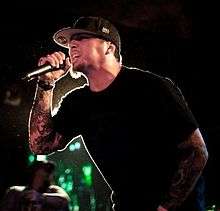
Rap metal bands institute the vocal and lyrical form of hip hop. Examples of rap metal include Crazy Town, Clawfinger, Stuck Mojo, Skindred and Rage Against The Machine. The thrash metal band Anthrax also helped pioneer the genre. Rap metal is often mislabeled as rapcore (a genre which fuses hardcore punk with hip hop) or nu metal, a genre which has similar elements in the music, rap metal usually does not include turntables or sampling into its sound, although keyboards are often used. Rap metal bands, unlike nu metal bands, are almost always fronted by rappers. Rap metal also lacks the melodic singing and growling commonly associated with nu metal.
Avant-garde metal

Avant-garde metal or avant-metal, also known as experimental metal, is a subgenre of heavy metal music loosely defined by use of experimentation and characterized by the use of innovative, avant-garde elements, large-scale experimentation, and the use of non-standard and unconventional sounds, instruments, song structures, playing styles, and vocal techniques. It evolved out of progressive rock, jazz fusion, and extreme metal, particularly death metal. Some local scenes include Los Angeles and the San Francisco Bay Area in the United States, Oslo in Norway, and Tokyo in Japan. Pioneers of experimental metal include Boris, Celtic Frost, Earth, Helmet, Maudlin of the Well, Neurosis, Sunn O))), and Voivod.
Black metal

Black metal is an extreme subgenre of heavy metal. Common traits include fast tempos, shrieked vocals, highly distorted guitars played with tremolo picking, blast beat drumming, raw recording, and unconventional song structures.
During the 1980s, several thrash metal bands formed a prototype for black metal. This so-called "first wave" included bands such as Venom, Bathory, Hellhammer and Celtic Frost.[26] A "second wave" arose in the early 1990s, spearheaded by Norwegian bands such as Mayhem, Burzum, Darkthrone, Immortal, and Emperor. The music of the early Norwegian black metal scene became a distinct genre.
Initially considered a synonym for "Satanic metal", black metal has often been met with hostility from mainstream culture, mainly due to the misanthropic and anti-Christian standpoint of many artists. Moreover, several of the genre's pioneers have been linked with church burnings and murder. Some have also been linked to neo-Nazism, however most black metal fans and most prominent black metal musicians reject Nazi ideology and oppose its influence on the black metal subculture.[27][28][29][30]
Derivatives of black metal
National Socialist black metal
NSBM typically melds Neo-Nazi beliefs (such as fascism, white supremacy, white separatism, antisemitism, xenophobia, and homophobia) with hostility to "foreign" religions (Christianity, Judaism, Islam, etc.). Bands often promote ethnic European paganism, occultism, or Satanism. Hendrik Möbus of Absurd described Nazism as the "most perfect (and only realistic!) synthesis of Satanic/Luciferian will to power, elitist Social Darwinism, connected to Aryan Germanic paganism". Members of the band Der Stürmer (named after the antisemitic newspaper edited by Julius Streicher) subscribe to esoteric Hitlerism, leaning on the works of Savitri Devi and Julius Evola.
Red and Anarchist black metal
Red and anarchist black metal, often shortened to the acronym RABM, is black metal in which the artists espouse various far-left and environmentalist ideologies such as anarchism, Marxism, and green anarchism.[31] It emerged as an amalgamation of black metal with anarchist crust punk,[19][32] and typically eschews the traditional Satanic and nihilist lyrics of black metal.[19][33] While some artists such as Iskra, Panopticon, Puna Terrori and Skagos overtly endorse political agendas and manifestos, others, such as Wolves in the Throne Room and some other Cascadian artists, would not explicitly associate with the red or anarchist label.[19] Other RABM artists include Storm of Sedition,[32] Not A Cost,[32] Black Kronstadt,[32] Crepehanger,[32] Leper,[32] Mutiny,[32] Fauna,[33] and Vidargangr.[34]
Symphonic black metal
Symphonic black metal is a style of black metal that incorporates symphonic and orchestral elements. This may include the usage of music workstation keyboards to conjure up "pseudo-orchestral" landscapes with default presets (e.g. strings, choirs, piano, organs, and pads), or full orchestral arrangements containing woodwind, brass, percussion, keyboards and strings. Bands like Carach Angren may feature solo instruments such as violins in addition to virtual or live orchestral arrangements. Vocals can be "clean" or operatic in style, and song structures are more defined or are inspired by symphonies, albeit not adhering to forms found in Western music (e.g. sonata, rondo, theme and variations) and following a typical riff-based approach. Many of the characteristics of traditional black metal are retained, such as shrieked vocals, fast tempos, high treble gain and tremolo picked electric guitars. Examples of symphonic black metal include Emperor and Dimmu Borgir.
Viking metal

Viking metal is a subgenre of heavy metal music with origins in black metal and Nordic folk music, characterized by a common lyrical and thematic focus on Norse mythology, Norse paganism, and the Viking Age. Its musical style is typically manifested as Nordic folk-influenced black metal. Some common traits include a slow paced and heavy riffing style, anthemic choruses, use of both clean and harsh vocals, a frequent use of folk instrumentation, and, often, the use of keyboards for atmospheric effect. Viking metal developed in the 1980s through the mid-1990s as a rejection of Satanism and the occult, instead embracing the Vikings and paganism as the leaders of opposition to Christianity. Most Viking metal bands originate from the Nordic countries, and nearly all bands claim that their members descend, directly or indirectly, from Vikings. Bathory, from Sweden, is generally credited with pioneering the genre with its albums Blood Fire Death (1988) and Hammerheart (1990). Enslaved, Burzum, Emperor, Storm and Falkenbach helped further develop the genre in the early through mid-1990s. The death metal bands Unleashed and Amon Amarth, which emerged during the early 1990s, also adopted Viking themes, broadening the genre from its primarily black metal origin. Other key bands in the genre include Darkwoods My Betrothed, Einherjer, Ensiferum, Moonsorrow, Thyrfing, and Windir.
War metal
War metal,[35] also known as war black metal[36] or bestial black metal,[37] is an aggressive,[36] cacophonous[35] and chaotic[35][36] black metal style, described by Rock Hard journalist Wolf-Rüdiger Mühlmann as "rabid"[36] and "hammering".[36] Important influences include first wave band Sodom,[35][36] first wave/death metal band Possessed[36] as well as old grindcore, black and death metal bands like Repulsion,[35][36] Autopsy,[36] Sarcófago[35][36][37][38] and the first two Sepultura releases.[36][38] War metal bands include Blasphemy,[35][36][38] Archgoat,[36] Impiety,[36] In Battle,[39] Zyklon-B.,[40] Eastern Front and to a certain extent the God Dethroned album 'Passiondale'.
Blackgaze
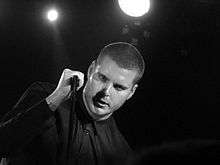
Blackgaze is a genre fusion of black metal and shoegazing that originated in the early 2000s.[41][42] The genre often incorporates heavier elements common of black metal including blast beat drumming and high-pitched screamed vocals with melodic elements and heavily distorted "wall of sound" guitar styles typically associated with shoegazing. The French shoegazing band Alcest is often credited with having influenced and formed the genre, while American bands such as Deafheaven have become synonymous as to defining the genre's characteristics.[43][44]
Christian metal

Christian metal, also known as white metal,[45] is a form of heavy metal music usually defined by its message using song lyrics as well as the dedication of the band members to Christianity. Christian metal is typically performed by professed Christians sometimes principally for Christians who listen to heavy metal music and often produced and distributed through various Christian networks.[46]
Christian metal artists exist in all the subgenres of heavy metal music, and the only common link among most Christian metal artists are the lyrics. The Christian themes are often melded with the subjects of the genre the band is rooted in, regularly providing a Christian take on the subject matter. It has been argued that the marginal yet transnational Christian metal subculture provides its core members an alternative religious expression and Christian identity, and that the music serves the purpose of offering a positive alternative or counterbalance to 'secular' metal music which is known for its generally dark and negative message.[46]
Christian metal emerged in the late 1970s as a means of evangelism to the wider heavy metal music scene, and was pioneered by American bands Resurrection Band and Petra and Sweden's Jerusalem. Los Angeles's Stryper achieved wide success in the 1980s. California's Tourniquet and Australia's Mortification led the movement in the 1990s. Rap metal group P.O.D. and the metalcore groups Underoath, Demon Hunter, As I Lay Dying, and Norma Jean (dubbed by Revolver Magazine as "The Holy Alliance") brought some mainstream attention to the movement in the first decade of the 21st century, achieving ranks in the Billboard 200.[47][48]
Derivatives of Christian metal
Unblack metal
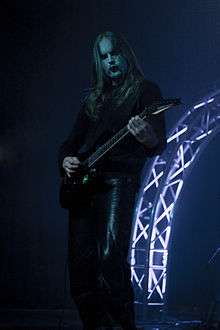
Unblack metal, sometimes called Christian black metal, is a genre of music that is stylistically black metal, but whose artists promote Christianity in their lyrics and imagery.[49] Such artists are controversial, mainly because black metal's pioneers, especially those of the Second Wave, intended to encourage hostility towards Christianity. It is also suggested that Christianity contradicts black metal's dark nature and the individualistic and misanthropic ideals of many bands.[50]
The exact beginning of the Christian black metal movement is disputed. The Australian band Horde's 1994 album Hellig Usvart brought the concept and the term holy unblack metal (a word play on Darkthrone's slogan "unholy black metal" used on the albums A Blaze in the Northern Sky and Under a Funeral Moon) to media attention. The Norwegian band Antestor formed in 1990 as a death/doom act and released its demo The Defeat of Satan in 1991, before they began shifting towards black metal on their 1994 album Martyrium. Other examples of unblack metal bands include Crimson Moonlight, Admonish, and Frosthardr.
Crust punk
Crust punk, often simply called crust, is a form of music influenced by anarcho-punk, hardcore punk and extreme metal.[51] The style, which evolved in the mid-1980s in England, often has songs with dark and pessimistic lyrics that linger on political and social ills. The term "crust" was coined by Hellbastard on their 1986 Ripper Crust demo.[52]
Crust is partly defined by its "bassy" and "dirty" sound. It is often played at a fast tempo with occasional slow sections. Vocals are usually guttural and may be growled or screamed. Crust punk takes cues from the anarcho-punk of Crass and Discharge[51] and the extreme metal of bands like Venom and Celtic Frost.[51][53] Notable crust punk bands include Amebix, Antisect and Doom.
Death metal

Death metal is an extreme subgenre of heavy metal music. It typically employs heavily distorted guitars, tremolo picking, deep growling vocals, blast beat drumming, minor keys or atonality, and complex song structures with multiple tempo changes.
Building from the musical structure of thrash metal and early black metal, death metal emerged during the mid-1980s.[54] Metal acts such as Slayer,[55][56] Kreator,[57] Celtic Frost,[58] and Venom were very important influences to the crafting of the genre.[54] Possessed[59] and Death,[60][61][62] along with bands such as Obituary, Carcass, Deicide and Morbid Angel are often considered pioneers of the genre.[63] In the late 1980s and early 1990s, death metal gained more media attention as popular genre niche record labels like Combat, Earache and Roadrunner began to sign death metal bands at a rapid rate.[64] Since then, death metal has diversified, spawning a variety of subgenres.[65]
Derivatives of death metal
Blackened death metal
Blackened death metal is a style that combines death metal and black metal. Examples of blackened death metal bands are Belphegor, Behemoth, Akercocke, Dissection and Sacramentum.
Death 'n' roll

"Death 'n' roll" is a term for death metal bands that incorporate rock and roll elements to their overall sound. The term is a blend of death metal and rock 'n' roll. The achieved effect is that of death metal's trademark combination of growled vocals and highly distorted detuned guitar riffing with elements reminiscent of 1970s hard rock and heavy metal.[66][67] Notable examples include Entombed, Six Feet Under, Gorefest, and Deuteronomium.
Melodic death metal
Melodic death metal, also referred to as melodeath or MDM, is a heavy metal music style that combines elements from the new wave of British heavy metal (NWOBHM) with elements of death metal. The style was developed during the early and mid-1990s, primarily in England and Scandinavia. The Swedish death metal scene in particular did much to popularize the style, which soon centered in the "Gothenburg metal" scene in Gothenburg, Sweden. Some prominent melodic death metal bands include Amon Amarth, At the Gates, Soilwork, Dark Tranquillity, Arch Enemy, In Flames, and Carcass.
Technical death metal
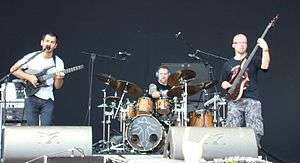
Technical death metal, often abbreviated to tech death, is characterized by fast, technically complex guitar and drum work, often including sweeping guitar solos. Vocals often adopt the guttural sound of death metal. Some of the first tech death bands include Death, Pestilence, Atheist, Nocturnus, Cynic, Origin and Cephalic Carnage. The music is often dark in nature.
Doom metal

Doom metal is an extreme form of heavy metal music that typically uses slower tempos, low-tuned guitars and a much "thicker" or "heavier" sound than other metal genres. Both the music and the lyrics intend to evoke a sense of despair, dread, and impending doom.[68] The genre is strongly influenced by the early work of Black Sabbath,[68] who formed a prototype for doom metal with songs such as "Black Sabbath", "Electric Funeral" and "Into the Void". During the first half of the 1980s,[68] a number of bands from England (Pagan Altar, Witchfinder General), the United States (Pentagram, Saint Vitus, Trouble) and Sweden (Candlemass, Count Raven) defined doom metal as a distinct genre.
Derivatives of doom metal
Death/doom
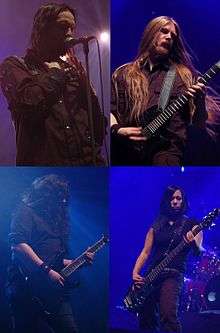
Death/doom, sometimes written as death-doom or deathdoom, is an extreme subgenre of heavy metal. It combines the slow tempos and pessimistic or depressive mood of doom metal with the deep growling vocals and double kick drumming of death metal.[69] The genre emerged in the mid-1980s and gained a certain amount of popularity during the 1990s, but had become less common by the turn of the 21st century.[69] In turn, death/doom gave rise to the closely related genre of funeral doom as well as to the more melodic and romantic gothic metal. The death/doom genre originated in the mid-1980s when the early progenitors like Dream Death began to mix traditional doom metal with the sounds of thrash and the nascent death metal scene.[70] Early records by such bands as Paradise Lost, My Dying Bride and Anathema combined the sounds of mid-1980s Celtic Frost and Candlemass with the use of female vocals,[71] keyboards and, in the case of My Dying Bride, violins.
Drone metal
))_%26_Boris_play_Altar_%40_ATP_NY_1.jpg)
Drone metal, also known as drone doom, began as a derivative of doom metal and it is largely defined by drones; notes or chords that are sustained and repeated throughout a piece of music. Typically, the electric guitar is performed with large amounts of reverb and feedback,[72] while vocals, if present, are usually growled or screamed. Songs are often very long and lack beat or rhythm in the traditional sense. Drone doom is generally influenced by drone music,[72] noise music[72] and minimalist music.[72] The style emerged in the early 1990s and was pioneered by Earth,[73] Boris[72] and Sunn O))).[72]
Funeral doom
Funeral doom is a style of doom metal that crosses death-doom with funeral dirge music. It is played at a very slow tempo, and places an emphasis on evoking a sense of emptiness and despair. Typically, electric guitars are heavily distorted and dark ambient aspects such as keyboards or synthesizers are often used to create a "dreamlike" atmosphere. Vocals consist of mournful chants or growls and are often in the background. Funeral doom was pioneered by Mournful Congregation (Australia), Esoteric (United Kingdom), Evoken (United States), Funeral (Norway), Thergothon (Finland), Skepticism (Finland) and Corrupted (Japan).
Sludge metal

Sludge metal began as a derivative of doom metal, incorporating hardcore punk and elements of Southern rock. Many sludge bands compose slow and heavy songs that contain brief hardcore passages.[74][75] However, some bands emphasize fast tempos throughout their music.[76] The string instruments are heavily distorted and are often played with large amounts of feedback to produce an abrasive, sludgy sound. Drumming is often performed in typical doom metal fashion, but drummers may employ hardcore d-beat or double-kick drumming during faster passages. Vocals are usually shouted or screamed, and lyrics are generally pessimistic in nature. Suffering, drug abuse, politics and anger towards society are common lyrical themes. New Orleans with its metal scene is often considered as its birthplace.[77] The style was pioneered in the early 1990s by bands such as Eyehategod,[74] Crowbar,[75] Buzzov*en[76] and Acid Bath.[78]
Extreme metal
Extreme metal consists of a number of related heavy metal music subgenres that have developed since the early 1980s, usually characterized by a more abrasive, harsher, underground, non-commercialized style or sound nearly always associated with genres like black metal, death metal, doom metal, thrash metal, and sometimes speed metal.[79]
Though many extreme sub-styles are not very well known to mainstream music fans, as extreme metal is by definition a counterculture, extreme metal has influenced an array of musical performers inside and outside of heavy metal.
Folk metal

Folk metal is a subgenre of heavy metal that developed in Europe during the 1990s. As the name suggests, the genre is a fusion of heavy metal with traditional folk music. This includes the widespread use of folk instruments and, to a lesser extent, traditional singing styles (for example, Dutch Heidevolk, Danish Sylvatica and Spanish Stone of Erech).
The earliest example of folk metal was the English band Golgotha, whose 1984 EP Dangerous Games contained a mixture of new wave of British heavy metal and folk styles. The genre was not further developed, however, until the emergence of another English band, Skyclad. Their debut album The Wayward Sons of Mother Earth was released in 1990. It was not until 1994 and 1995 that other early contributors in the genre began to emerge from different regions of Europe as well as in Israel. Among these early groups, the Irish band Cruachan and the German band Subway to Sally each spearheaded a different regional variation that over time became known as Celtic metal and medieval metal respectively. Despite their contributions, folk metal remained little known with few representatives during the 1990s. It was not until the early 2000s when the genre exploded into prominence, particularly in Finland with the efforts of such groups as Finntroll, Ensiferum, Korpiklaani, Turisas, and Moonsorrow.
The music of folk metal is characterized by its diversity, with bands known to perform different styles of both heavy metal music and folk music. A large variety of folk instruments are used in the genre with many bands consequently featuring six or more members in their regular line-ups. A few bands are also known to rely on keyboards to simulate the sound of folk instruments. Lyrics in the genre commonly deal with mythology, history, and nature.
Derivatives of folk metal
Celtic metal

Celtic metal is a subgenre of folk metal that developed in the 1990s in Ireland. As the name suggests, the genre is a fusion of heavy metal music and Celtic music. The early pioneers of the genre were the three Irish bands Cruachan, Primordial and Waylander. The genre has since expanded beyond Irish shores and is known to be performed today by bands from numerous other countries.
Pirate metal
Pirate metal is a subgenre of folk metal that blends heavy metal, thrash metal, and sometimes speed metal with pirate mythology, and, commonly, elements of sea shanties. The style was influenced heavily by German heavy metal band Running Wild and its third studio album, Under Jolly Roger. Popular Pirate metal bands include Alestorm and Swashbuckle.
Medieval metal
Medieval metal or medieval rock is a subgenre of folk metal that blends hard rock or heavy metal music with medieval folk music. Medieval metal is mostly restricted to Germany where it is known as "Mittelalter-Metal" or "Mittelalter-Rock."[80][81] The genre emerged from the middle of the 1990s with contributions from Subway to Sally, In Extremo and Schandmaul. The style is characterized by the prominent use of a wide variety of traditional folk and medieval instruments.
Pagan metal
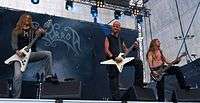
Pagan metal is heavy metal music that fuses extreme metal with "the pre-Christian traditions of a specific culture or region through thematic concept, rustic melodies, unusual instruments or archaic languages",[82][83] usually referring to folk metal or black metal. The Norwegian band In the Woods... was one of the first bands commonly viewed as pagan metal.[84][85] Metal Hammer author Marc Halupczok wrote that Primordial's song "To Enter Pagan" from the band's demo "Dark Romanticism" contributed to defining the genre.[86] Pagan metal bands are often associated with Viking metal and folk metal. Bands such as Moonsorrow and Kampfar have been identified as fitting within all three of those genres.[87][88]
Glam metal
Glam metal (also known as hair metal or pop metal) is the visual style of certain heavy metal bands that arose in the late 1970s and early 1980s in the United States, particularly on the Los Angeles Sunset Strip music scene. It was popular throughout the 1980s and briefly in the early 1990s, combining the flamboyant look of glam rock and playing a commercial hard rock/heavy metal musical style. The term Hair bands was popularized by MTV in the 1990s and derives from the tendency among glam metal acts to style their long hair in a teased-up fashion. Many of the bands donned make-up to achieve an androgynous look, similar to that of some 1970s glam rock acts. Mötley Crüe, Stryper, Bon Jovi, Poison and Ratt are examples of bands who adopted the glam metal look in their stage attire and their music video imagery.
Gothic metal
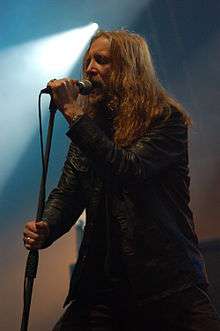
Gothic metal is characterized as a combination of the dark atmospheres of gothic rock and darkwave with the heaviness of doom metal.[89] The genre originated during the mid-1990s in Europe as an outgrowth of doom-death, a fusion genre of doom metal and death metal. Examples of gothic metal bands include Paradise Lost, My Dying Bride, Anathema, Tiamat, Type O Negative, Moonspell, Theatre of Tragedy, and Lacuna Coil.
Grindcore

Grindcore is a fusion of crust punk, hardcore punk and thrash metal or death metal. It is characterized by growling vocals, blast beats, and incredibly short songs with lyrics that are often focused on gore and violence, though sometimes the lyrics can be political. Grindcore, in contrast to death metal, is often very chaotic, and lacks the standard use of time signatures. The style was pioneered by the British band Napalm Death in the eighties. Other notable grindcore bands include Brutal Truth, Anal Cunt and Pig Destroyer.
Derivatives of grindcore
Deathgrind
Deathgrind, sometimes written as death-grind or death/grind, is a musical genre that fuses death metal and grindcore. Deathgrind has been described as "grindcore and brutal death metal colliding head on."[90] Danny Lilker described deathgrind as "combining the technicality of death metal with the intensity of grindcore."[91] Death/grind emphasizes overall musical brutality with a specific focus on speed-soaked fury and retains grindcore's traditional abruptness.[92] Notable bands include Cattle Decapitation , Mortician (band) and Misery Index.
Goregrind

Goregrind is a subgenre of grindcore and death metal.[93] Early examples of the genre include Repulsion's Horrified, Impetigo's Ultimo Mondo Cannibale,[94] and first two studio albums Carcass, which defined the genre.[95] In its Reek of Putrefaction-era, Carcass used pitch shifters, medical imagery, and, in a deviation from the frequently political or left-wing lyrics commonly used in the hardcore punk and grindcore scenes, gory, anatomical references in its lyrics.
Pornogrind
Pornogrind, also known as porno grind, porno-grind or porn grind, is a musical subgenre of grindcore and death metal, which lyrically deals with sexual themes. Natalie Purcell's book Death Metal Music: The Passion and Politics of a Subculture, suggests that pornogrind is defined solely on the basis of its lyrical content and unique imagery, its focus on pornographic content. Purcell notes that bands like Gut include "simpler, slower, and more rock-like songs". The artwork for pornogrind bands' albums is noted for its extreme and potentially offensive nature, which "would keep them out of most stores". Other notable bands of the genre include Cock and Ball Torture and Rompeprop.
Industrial metal

Industrial metal combines elements of industrial music and heavy metal. It is usually centered around repetitive metal guitar riffs, sampling, synthesizer or sequencer lines, and distorted vocals.[96] Prominent industrial metal groups include Ministry, Nine Inch Nails, KMFDM, Fear Factory, Marilyn Manson,[97] and Godflesh.[98]
Kawaii metal
At its core, Kawaii metal (also known as idol metal[99] or cute metal[100]) fuses aspects of heavy metal and j-pop,[101][102][103][104] however usually uses elements of power metal mixed with industrial metal keyboards and synthesizers, japanese idol aesthetic and vocals,[105] shredding guitar solos and flashing drums[106] with occasional usage of melodic death metal and post-hardcore unclean vocals and Traditional Japanese musical instruments.[105] Kawaii metal grew out of the japanese idol in the late 2000s and early 2010s, being pioneered by bands like Dazzle Vision, Babymetal and Ladybaby.[105]
Latin metal

Latin metal is a genre of metal music with Latin origins, influences, and instrumentation, such as Spanish vocals, Latin percussion and rhythm such as Salsa rhythm. Prominent bands in this genre include A.N.I.M.A.L., Ill Niño, Nonpoint, Sepultura and Soulfly.
Metalcore

Metalcore combines heavy metal and hardcore punk. Generally, metalcore guitarists use heavy guitar riffs and solos, drummers frequently use hardcore Blast beats and double bass drums, and vocalists use a vocal style which includes death growls and shouting. A distinguishing characteristic is the "breakdown", whereby the song is slowed to half-time and the guitarists play open strings to achieve the lowest-pitched sound. Prominent Metalcore bands include Hatebreed, Bury Your Dead, Killswitch Engage, While She Sleeps, Asking Alexandria, Bleeding Through, Integrity Unearth, and Parkway Drive. Original metalcore bands from the 1990s included Earth Crisis, Hatebreed, Integrity and Converge. More modern bands include Avenged Sevenfold, Killswitch Engage, Underoath, All That Remains, Trivium, As I Lay Dying, Bullet for My Valentine, Shadow's Fall, Unearth, Atreyu, and Bleeding Through.
Derivatives of metalcore
Melodic metalcore

Melodic metalcore is a fusion genre which combines sounds and traits from melodic death metal with hardcore punk, metalcore and occasionally emo.[107] Melodic metalcore bands include Trivium,[108][109] All That Remains,[110] Atreyu,[107][111][112] Bullet for My Valentine,[113] Bury Tomorrow,[114] Darkest Hour,[111] Asking Alexandria,[115] As I Lay Dying,[116][117] August Burns Red[118][119][120] and The Devil Wears Prada.[121]
Melodic metalcore bands have big influences, guitar riffs, and writing styles from Swedish melodic death metal band such as At the Gates, Arch Enemy, In Flames and Soilwork.[111][122] They tend to have strong use of instrumental melody. Many melodic metalcore can have clean singing as their vocals as well as growls and screaming. It also can feature harmonic guitar riffs, tremolo picking, double bass drums and metalcore-stylized breakdowns.[123][124][125] Some bands also may feature guitar solos.[112] A few of these groups, like Shadows Fall, have some appreciation for 1980s glam metal.[126] Melodic metalcore groups have been described as "embrac[ing] '80s metal clichés", such as "inordinate amounts of smoke machines, rippin' solos, [and] three bass drums."[112]
Deathcore
Deathcore combines elements of death metal with elements of metalcore or hardcore punk, or both.[127][128] It is defined by an "excessive" use of death metal riffs, blast beats and use of hardcore punk breakdowns.[129][130] Some prominent bands include the Acacia Strain, Carnifex, Despised Icon, Suicide Silence, Rings of Saturn, and Whitechapel.
Mathcore
Mathcore, not to be confused with math metal, is a rhythmically complex and dissonant style of metalcore. It has its roots in bands such as Converge,[131] Botch,[132][133] and The Dillinger Escape Plan.[134] The term mathcore is suggested by analogy with math rock. Both math rock and mathcore make use of unusual time signatures. Prominent mathcore groups have been associated with grindcore.[135][136][137][138][139]
Neoclassical metal
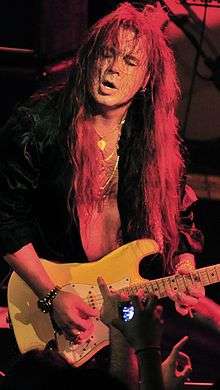
Neoclassical metal, also known as shred metal, is a subgenre that is heavily influenced by classical music in its style of composition. It uses a very technical style of guitar soloing called shred guitar, in which guitarists use cross-picking, sweep picking, and economy picking to play rapid scales and arpeggios. As well, it uses elements borrowed from classical music; including instruments, scales and melodies. Yngwie J. Malmsteen, Tony MacAlpine and Vinnie Moore are prominent performers in this genre.
Neue Deutsche Härte

Neue Deutsche Härte ("New German Hardness") describes a crossover style that is influenced by New German Wave, alternative metal and groove metal combining it with elements from industrial, electronica and techno.[140] The lyrics are generally in German, and dance metal is the term most commonly used to describe Neue Deutsche Härte songs sung in other languages. NDH uses the basic setup of instruments for metal: electric guitar, bass guitar, drums and vocals, along with keyboard, synthesizers, samples and occasionally additional percussion. Emphasis is on a demonstration of predominance, by over-pronouncing certain syllables and letters (such as the uvular or alveolar trill). The vocals are thus dominantly presenting in deep, male, and clean voice.[140] Some bands use screaming and death growls, which is also common, being heard in certain songs by Oomph!, Rammstein, Stahlhammer (literally "Steel Hammer"), Samsas Traum and Megaherz. NDH imagery is often strongly masculine, and at times militaristic, depending on the group and the song. Guitars are tuned low, usually to drop D or C, and are generally heavily distorted.
Post-metal

This heavy metal movement takes influences from post-rock. While it is in many ways similar to post-rock, post-metal tends to include lower-tuned guitars, distorted guitar(s), heavy atmospherics, gradual evolution of song structure, and a minimal emphasis on vocals. Post-metal stresses emotion, contrasting the ambiance of post-rock with the weight and bombast of metal. Vocals are deemphasized or non-existent, and lyrics tend to be equally abstract: often thematic or philosophical in nature. It is a largely American phenomenon, but also includes some Japanese bands. Bands like Neurosis, Isis, Cult of Luna and Pelican write lengthy songs (typically five or six per album) that can range from light and guitar-driven to heavy, drum and bass-driven.
Power metal

Power metal takes influence from heavy metal and speed metal, and often emphasizes clean, melodic, high-pitched vocals, and fast pacing that is mostly driven by double bass drumming and melodic lead guitar. The rhythm guitar is defined by straight power chord progressions. Sometimes, harsh vocals are used, but usually only as backing vocals. Power metal lyrics usually involve fantasy themes. The songs often have a theatrical, epic, and emotionally "powerful" sound.[141] Power metal is generally more upbeat than other metal genres, seeking to empower the listener and inspire joy and courage.
The term was first used in the middle of the 1980s[142] and refers to two different but related styles: the first pioneered and largely practiced in North America with a harder sound similar to speed metal, and a later more widespread and popular style based in Europe (especially Germany, Finland, Italy and Scandinavia), Latin America (Argentina, Brazil) and Japan, with a lighter, more melodic sound and frequent use of keyboards. Examples of power metal bands include DragonForce, Blind Guardian, Helloween, Sonata Arctica, Angra, Sabaton, Stratovarius, Kamelot, and HammerFall.[143]
Progressive metal

Progressive metal is a fusion between progressive rock and heavy metal. It is one of heavy metal's more complex genres, due to its use of unusual and dynamic time signatures, long compositions, complex compositional structures, and skilled instrumental playing, where instrumental solos are detailed and extended. However, the latest age of progressive metal has favored rougher lyrics and lower-pitched riff sequences with high amounts of strumming. Vocals, if present, are melodic (though there are a few that utilise unclean vocals), and lyrics are often philosophical, spiritual, or political. Many bands of the genre were influenced by the progressive rock band Rush, who would often incorporate elements of heavy metal into their music. Examples of the genre include Queensrÿche, Dream Theater, Opeth, Tool, Fates Warning, and Pain of Salvation.
Derivatives of progressive metal
Djent
Djent, also known as djent metal,[144] is a musical subgenre that emerged as a spin-off from progressive metal.[145][146] The word "djent" is an onomatopoeia for a heavily palm-muted, distorted guitar chord. Typically, the word is used to refer to music that makes use of this sound, to the sound itself, or to the scene that revolves around it.[147] Djent as a style has been described as featuring heavily palm-muted, distorted guitar chords alongside virtuoso soloing,[145] and is characterized by rhythmic complexity and palm-muted riffing.[148] Pioneering bands in the style are Meshuggah, Periphery, Animals As Leaders, TesseracT, and Textures.
Speed metal
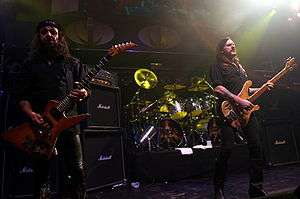
Speed metal originated in the late 1970s and early 1980s out of the new wave of British heavy metal, and was the direct musical progenitor of thrash metal.[149] When speed metal first emerged as a genre, it increased the tempos that had been used by early heavy metal bands, while retaining their melodic approaches. Influenced by hardcore punk, speed metal is very fast, abrasive, and technically demanding.[32] Examples of speed metal include Venom, Motörhead, Annihilator and Accept.
Stoner metal
Stoner rock or stoner metal is typically slow-to-mid tempo, low-tuned, and bass-heavy.[150] It combines elements of psychedelic rock, blues-rock and doom metal, often with melodic vocals and 'retro' production.[151] The genre emerged during the early 1990s and was pioneered foremost by the Californian bands Kyuss[152] and Sleep.[153] Other prominent stoner metal bands include Acid King, Electric Wizard, Mastodon and Black Label Society.
Symphonic metal

Symphonic metal most commonly refers to metal bands that use orchestral elements in their music, either through having an actual orchestra, a few classical instruments, or keyboards that simulate the sounds of classical instruments. Prominent examples of symphonic metal include the bands Nightwish, Within Temptation, Epica, Rhapsody of Fire, and Therion.
Thrash metal

Thrash metal is often regarded as the first form of extreme metal. It is generally characterized by its fast tempos, complexity and aggression. Thrash metal guitar playing is most notable for the "chugging" sound it creates through low-pitched palm muted riffs, and high-pitched shred guitar solos. Drummers often use double-kick and double-bass drumming. Vocals are most often shouted or sung in an aggressive manner.
Thrash metal evolved from speed metal, NWOBHM and early hardcore punk at the beginning of the 1980s. Bands such as Metallica, Slayer, Megadeth and Anthrax spearheaded thrash metal and are referred to as the genre's "Big Four", while on the European side Sodom, Kreator, Destruction, and Tankard form the so-called "Big Teutonic Four".
Derivatives of thrash metal
Crossover thrash
Crossover thrash, often abbreviated to "crossover,"[154] and sometimes called also "punk metal," is a form of thrash metal that contains more hardcore punk elements than standard thrash. The genre lies on a continuum between heavy metal and punk rock. The genre is often confused with thrashcore, which is essentially a faster hardcore punk rather than a more punk-oriented form of metal.[149][155] Corrosion of Conformity, Dirty Rotten Imbeciles, Stormtroopers of Death, Suicidal Tendencies and Discharge are major bands in the genre.
Groove metal
Groove metal, also known as neo-thrash, post-thrash, or power groove, consists of slow or mid-tempo and down tuned thrash riffs, bluesy guitar solos, greatly emphasized drum work and harsh vocals. Examples of groove metal include Pantera, Lamb of God, Machine Head, DevilDriver, Sepultura and A.N.I.M.A.L..
Teutonic thrash metal
Teutonic thrash metal, or just Teutonic metal, is a regional form of thrash metal that originated in Germany during the 1980s and was heavily influenced by the new wave of British heavy metal. Teutonic thrash is often considered to be "less thrashy" than regular thrash metal, and the style is known to incorporate raspy vocals, palm muted guitar riffs, and frantic double bass drumming. Notable Teutonic bands include Kreator, Destruction, Sodom, Holy Moses, Iron Angel, and Living Death.
Traditional heavy metal

Traditional heavy metal, also known as classic metal[156] or often simply heavy metal, is the group of bands and artists who play a metal music style similar to the style heard before the genre evolved and splintered into many different styles and subgenres.[157] It is characterized by mid-to-fast-tempo riffs, by thumping basslines, crunchy riffs, extended lead guitar solos, and clean, often high-pitched vocals and anthemic choruses. It is not generally categorized as a subgenre of metal, but the main genre of it. Examples include Black Sabbath, Led Zeppelin, Alice Cooper, AC/DC, Judas Priest, and Kiss.
References
- ↑ Grierson, Tim. "Alternative Metal – What Is Alternative Metal – Alt-Metal History". About.com. Retrieved July 7, 2010.
- ↑ "Alternative Metal". Allmusic. Retrieved July 15, 2012.
- 1 2 3 https://www.spin.com/2013/03/tool-opiate-reissue-limited-edition-adam-jones/
- ↑ "Things to do in Mumbai today". Mumbai Mirror.
- ↑ rollingstoneindia.com/american-alt-metal-band-faith-no-more-return/
- ↑ "Helmet Album Preview: Musically Mature, But Still Tough As Nails". MTV News.
- ↑ https://noisecreep.com/life-of-agony-finish-20th-anniversary-celebration-plan-for-futu/
- ↑ Tool forced to delay work on new album after freak scooter crashes - NME
- ↑ "Modern rock returns to the New Orleans radio airwaves with newly christened ROCK 96.3". NOLA.com.
- ↑ https://www.popmatters.com/review/chevelle-vena-sera/
- ↑ Los Angeles Times (19 August 2015). "Godsmack to end its fall tour with a stop in Las Vegas". latimes.com. Retrieved 28 February 2016.
- ↑ https://www.revolvermag.com/tag/system-of-a-down/page/4
- ↑ Potter, Valerie (July 1991). "Primus: Nice and Cheesy". Hot Metal. Sydney, Australia. 29.
- ↑ Darzin, Daina; Spencer, Lauren (January 1991). "The Thrash-Funk scene proudly presents Primus". Spin. 6 (10): 39.
- ↑ Pieslak, Jonathan (2008). "Sound, text and identity in Korn's 'Hey Daddy'". Popular Music. 27: 35–52. doi:10.1017/S0261143008001451.
- ↑ Tompkins, Joseph (2009). "What's the Deal with Soundtrack Albums? Metal Music and the Customized Aesthetics of Contemporary Horror". Cinema Journal. 49 (1). doi:10.1353/cj.0.0155.
- 1 2 McIver, Joel (2002). "How is nü-metal different from old metal?". Nu-metal: The Next Generation of Rock & Punk. Omnibus Press. pp. 12–13. ISBN 0-7119-9209-6.
- ↑ McIver, Joel (2002). "How did we get to nü-metal from old metal?". Nü-metal: The Next Generation of Rock & Punk. Omnibus Press. pp. 10; 12. ISBN 0-7119-9209-6.
- 1 2 3 4 Burgess, Aaron (September 9, 2014). "10 Nu-Metal Albums You Need to Own". Revolver. Retrieved October 5, 2015.
- ↑ "Coal Chamber's Dez Fafara: Nu Metal Has 'Never Left' - Blabbermouth.net". BLABBERMOUTH.NET.
- ↑ "Artists :: LINKIN PARK". MusicMight. 2008-08-03. Retrieved 2013-03-04.
- ↑ Udo, Tommy (2002). Brave Nu World. Sanctuary Publishing. pp. 124–138, 237–239. ISBN 1-86074-415-X.
- ↑ Udo, Tommy (2002). Brave Nu World. Sanctuary Publishing. pp. 166–169, 235. ISBN 1-86074-415-X.
- ↑ Udo, Tommy (2002). Brave Nu World. Sanctuary Publishing. pp. 139–149, 242. ISBN 1-86074-415-X.
- ↑ McIver, Joel (2003). Black Sabbath: Sabbath Bloody Sabbath. Music Sales Group. p. 295. ISBN 085712028X. Retrieved 2012-05-20.
- ↑ Sam Dunn (director) (2005). Metal: A Headbanger's Journey (motion picture). Seville Pictures.
- ↑ Mladen Škot. "Interview with Jotunspor". Maelstrom. Retrieved 5 December 2011.
- ↑ "Gorgoroth guitarist Infernus: "I personally am against racism in both thought and practice"". Blabbermouth.net. 15 March 2008. Retrieved 5 December 2011.
- ↑ Bill Zebub (director) (2007). Black Metal: A Documentary (motion picture). Bill Zebub Productions.
- ↑ YouTube.
- ↑ "If It Ain't Got No Blastbeat, It's Not My Revolution: Panopticon". PopMatters. Retrieved 2016-05-10.
- 1 2 3 4 5 6 7 8 "Canadian Crust Punks Storm of Sedition Go Off the Grid on Their Furious New 'Decivilize' LP | NOISEY". NOISEY. Retrieved 2016-05-10.
- 1 2 "Skagos: Anarchic Album Review | Pitchfork". pitchfork.com. Retrieved 2016-05-10.
- ↑ Berto. "Review Vidargangr - A World That has To Be Opposed". Lords of Metal. Retrieved 2016-05-10.
- 1 2 3 4 5 6 7 Robert Müller: Wollt Ihr den ewigen Krieg?. Der tote Winkel. In: Metal Hammer, November 2011.
- 1 2 3 4 5 6 7 8 9 10 11 12 13 14 Wolf-Rüdiger Mühlmann: War Black Metal: Die Extremsten der Extremen. Was bleibt, ist Schutt und Asche. In: Rock Hard, no. 279, pp. 71–73.
- 1 2 Wolf-Rüdiger Mühlmann: SARCOFAGO. I.N.R.I. In: Rock Hard, Nr. 304, September 2012, p. 73.
- 1 2 3 Wolf-Rüdiger Mühlmann: Impaled Nazarene. Tol Cormpt Norz Norz Norz. In: Rock Hard, no. 307, December 2012, p. 77.
- ↑ Ekeroth, David (2008). Swedish Death Metal. Bazillion Points. p. 359. ISBN 978-0-9796163-1-0. Retrieved 13 March 2012.
- ↑ Christe, Ian (17 February 2004). Sound of the beast: the complete headbanging history of heavy metal. HarperCollins. p. 281. ISBN 978-0-380-81127-4. Retrieved 13 March 2012.
- ↑ "The Translator Blackgaze". Retrieved 2015-10-06.
- ↑ Howells, Tom. "Blackgaze: meet the bands taking black metal out of the shadows". the Guardian. Retrieved 2015-10-06.
- ↑ "Deconstructing: Alcest's Shelter And Metal In A Post-Deafheaven World". Retrieved 2015-10-06.
- ↑ "Deafheaven: Sunbather". Retrieved 2015-10-06.
- ↑ John J. Thompson, Raised by Wolves: the Story of Christian Rock & Roll (Ottawa, Ontario Canada:, Ontario: ECW Press, 2000), ISBN 1-55022-421-2, pp. 153–4.
- 1 2 Moberg, Marcus (November 3, 2008). Turn or Burn? The Peculiar Case of Christian Metal Music (PDF). Heavy Fundamentalisms: Music, Metal & Politics. Salzburg, Austria: Inter-Disciplinary.Net.
- ↑ "Satellite: Awards". AllMusic. Retrieved 14 June 2012.
- ↑ Johnson, Wesley. "Revolver on Christian metal". Buzz Grinder. Retrieved 2007-12-19.
The cover of the latest Revolver Magazine features members of As I Lay Dying, Norma Jean, Underoath and Demon Hunter. The photo goes along with an extensive write-up on Christian Metal, which they've dubbed "phenomenon of the year."
- ↑ Kapelovitz, Dan (February 2001). "Heavy Metal Jesus Freaks – Headbanging for Christ". Mean Magazine. Archived from the original on 2007-08-05. Retrieved 2007-09-06.
And where secular Black Metal thrived, so did its Christian counterpart, Unblack Metal, with names like Satanicide, Neversatan, and Satan's Doom.
- ↑ "Kittil Kittilsen, Beat the Blizzard".
- 1 2 3 Von Havoc, Felix (1984-01-01). "Rise of Crust". Profane Existence. Archived from the original on 2008-06-15. Retrieved 2008-06-16.
- ↑ Glasper 2009, 185
- ↑ Glasper 2006. "Amebix." p. 198-201.
- 1 2 Dunn, Sam (Director) (August 5, 2005). Metal: A Headbanger's Journey (motion picture). Canada: Dunn, Sam.
- ↑ Joel McIver Extreme Metal, 2000, Omnibus Press pg.14 ISBN 88-7333-005-3
- ↑ The greatest metal band for Mtv Archived July 18, 2006, at the Wayback Machine.
- ↑ Joel McIver Extreme Metal, 2000, Omnibus Press pg.100 ISBN 88-7333-005-3
- ↑ Joel McIver Extreme Metal, 2000, Omnibus Press pg.55 ISBN 88-7333-005-3
- ↑ Rivadavia, E. Possessed: Biography, allmusic, (accessed August 13, 2008)
- ↑ allmusic ((( Death > Biography )))
- ↑ "Metal Rules!!: Interview with Chuck Schuldiner".
- ↑ "The Best Of NAMM 2008: Jimmy Page, Satriani Models Among The Highlights".
- ↑ Morbid Angel page @ Allmusic "Formed in 1984 in Florida, Morbid Angel (along with Death) would also help spearhead an eventual death metal movement in their home state"
- ↑ Is Metal Still Alive? WATT Magazine, Written by: Robert Heeg, Published: April 1993
- ↑ Silver Dragon Records "During the 1990s death metal diversified influencing many subgenres"
- ↑ Cosmo Lee. "Stylus magazine review". www.stylusmagazine.com. Retrieved 2008-07-18.
"Death 'n' roll" arose with Entombed's 1993 album Wolverine Blues ... Wolverine Blues was like '70s hard rock tuned down and run through massive distortion and death growls.
External link in|publisher=(help) - ↑ Huey, Steve. "((( Gorefest > Biography )))". www.allmusic.com. Retrieved 2008-02-15.
Erase, was released in 1994 and found the band moving subtly toward more traditional forms of metal, partly through its sure sense of groove. That approach crystallized on 1996's Soul Survivor, which combined death metal with the elegant power and accessibility of '70s British metal.
External link in|publisher=(help) - 1 2 3 "Doom metal". Allmusic. Retrieved 2008-07-21.
- 1 2 Tracey, Ciaran (March 2006). "Doom/Death: United in Grief" , Terrorizer #142, pp.54–55.
- ↑ Bardin, Olivier (May 2006). "Forgotten Doom: Raiders of the Lost Art", Terrorizer #144, p.56
- ↑ Purcell, Nathalie J. (2003). Death Metal Music: The Passion and Politics of a Subculture. McFarland & Company. p. 23. ISBN 0-7864-1585-1. Retrieved April 2008. Check date values in:
|access-date=(help) - 1 2 3 4 5 6 John Wray, "Heady Metal", New York Times, May 28, 2006. Access date: August 18, 2008.
- ↑ Jason Jackowiak, Splendid, September 14, 2005. Access date: August 23, 2008.
- 1 2 Huey, Steve. "Eyehategod". Allmusic. Retrieved 2008-07-21.
- 1 2 Huey, Steve. "Crowbar". Allmusic. Retrieved 2008-07-21.
- 1 2 York, William. "Buzzov*en". Allmusic. Retrieved 2008-07-21.
- ↑ "Doom metal". Allmusic. Retrieved 2008-07-21.
- ↑ York, William. "Acid Bath". Allmusic. Retrieved 2008-07-21.
- ↑ K. Kahn-Harris, Extreme Metal: Music and Culture on the Edge (Berg Publishers, 2007), ISBN 1-84520-399-2, p. 31.
- ↑ Duden – Das neue Wörterbuch der Szenesprachen ("The new Dictionary of Scene Languages") (in German). Bibliographisches Institut AG. ISBN 978-3-411-71092-8.
- ↑ "Mittelalter-Rock" (in German). rock-musiker.de.
- ↑ Wiederhorn 2009, p. 62.
- ↑ Cummins, Johnson (April 2009). "Myth Demeanour: Finland's Korpiklaani lead the pagan metal pack". Montreal Mirror. 24 (44). Retrieved 2009-05-11.
- ↑ Wachter, Christian (2008). "Progressive Heiden". Pagan Fire (2). p. 51.
Eine der ersten Gruppen, die übereinstimmend als Pagan Metal-Band bezeichnet wurde, waren bekanntlich In The Woods...
- ↑ Halupczok, Marc (March 2010). "Waldschrate & Met-Trinker". Metal Hammer. p. 30.
1992 gegründet, wurden In The Woods... als eine der ersten Bands überhaupt als reine Pagan-Band bezeichnet oder dem Black Metal zugerechnet.
- ↑ Halupczok, Marc (March 2010). "Waldschrate & Met-Trinker". Metal Hammer. p. 31.
Mit 'To Enter Pagan' vom Demo DARK ROMANTICISM definierten sie ein ganzes Genre mit.
- ↑ Bowar, Chad. "Moonsorrow – Viides Luku: Hävitetty". About.com. Retrieved 2009-05-11.
- ↑ Bowar, Chad. "Kampfar – Kvass Review". About.com. Retrieved 2009-05-11.
- ↑ "Heavy Metal Artists and Heavy Metal Styles". [heavymetal.about.com]. Retrieved 2012-12-01.
- ↑ "Grind Prix" (2005). Zero Tolerance #004, p. 46.
- ↑ Lilker, Danny, Grind Your Mind: A History of Grindcore liner notes. Mayan Records, MYNDD056, 2007.
- ↑ Schwarz, Paul, "Death Metal|Death/Grind" (2006). Terrorizer #150, p. 54.
- ↑ Purcell, Natalie J. (2003). Death Metal Music: The Passion and Politics of a Subculture. McFarland. pp. 23–24. ISBN 0-7864-1585-1. Retrieved 2007-11-28.
- ↑ Badin, Olivier (2009). "Goregrind". Terrorizer, 181, p.41.
- ↑ Widener, Matthew. Carcass Clones. Decibel Magazine. Archived from the original on 2008-01-16. Retrieved 2009-02-27.
- ↑ "Industrial Metal". Retrieved 2008-02-11.
- ↑ Di Perna 1995a, page 69.
- ↑ Walters, Martin. "((( Godflesh > Overview )))". Retrieved 2008-07-03.
- ↑ "Cracked - Idol Metal".
- ↑ "Huffington Post - BABYMETAL".
- ↑ "Team Rock - Kawaii Metal".
- ↑ "Barks - Babymetal".
- ↑ "Nerdist - Babymetal".
- ↑ "Anglo Bubble - Babymetal".
- 1 2 3 "That's Rocking Awesome - Kawaii Metal".
- ↑ "SDP - Kawaii Metal".
- 1 2 Lee, Cosmo; Voegtlin, Stewart. "Into the void: Stylus Magazine's Beginner's Guide to Metal – Article – Stylus Magazine". Stylus Magazine. Retrieved 17 May 2010.
- ↑ "Trivium – In Waves CD Review". Hard Rock Haven. September 1, 2011.
- ↑ ""IN WAVES": LET THE ARGUING ABOUT THE NEW TRIVIUM SONG BEGIN!". MetalSucks. May 23, 2011.
- ↑ Rivadavia, Eduardo. "Overcome review". Allmusic. Retrieved 17 February 2012.
Overcome offers very dependable melodic metalcore in the spirit of All That Remains' albums past, without succumbing to outright stagnation.
- 1 2 3 D. Taylor, Jason. "Suicide Notes and Butterfly Kisses review". Allmusic. Retrieved June 24, 2008.
Atreyu's debut album, Suicide Notes and Butterfly Kisses, is an invigorating foray into melodic metalcore in the vein of Darkest Hour, Poison the Well, and Eighteen Visions.
- 1 2 3 "Taste of Chaos", Revolver, June 2008, p. 110. "This is the Rockstar Taste of Chaos Tour, a night when heavier melodic-metalcore bands like Atreyu and Avenged Sevenfold intend to position themselves as the next generation of bands to actually pack arenas (...)".
- ↑ Apar, Corey. "Bullet for My Valentine". Allmusic. Retrieved November 8, 2011.
- ↑ Phil Freeman (16 March 2010). "Alternative Press | Reviews | Bury Tomorrow – Portraits". Alternative Press. Retrieved 9 July 2012.
If you're wondering whether they bring anything unique or unexpected to the table, the answer is no. Is Portraits a pleasurable enough melodic metalcore album while it's playing? Absolutely.
- ↑ Jim (2010-05-02). "Asking Alexandria Interview: SXSW 2010". Spinner. Retrieved 2013-06-23.
- ↑ "As I Lay Dying – Awakened". Rock n Reel Reviews.
- ↑ "Album Review! As I Lay Dying – Awakened". Headbang or GTFO.
- ↑ "August Burns Red – Constellations". Way Too Loud!. July 15, 2012.
- ↑ "Eternal Closure". Sputnikmusic. Retrieved January 2, 2012.
- ↑ "August Burns Red Burns Red Presents Sleddin' Holiday Album". Bradley Zorgdrager. October 9, 2012.
- ↑ "The Devil Wears Prada 'Dead Throne' is an Ambush of Sound – Album Review". Audio Ink Radio. September 2011.
- ↑ Metal Injection, August 28, 2007. Access date: June 24, 2008.
- ↑ "Ignominious Incarceration – Of Winter Born". Way Too Loud!. April 30, 2009.
- ↑ "It's Through the Approach". El Paisano. September 12, 2007. Retrieved June 24, 2008.
- ↑ "Suicide Notes and Butterfly Kisses review". mp3.com. Archived from the original on February 12, 2009.
- ↑ Dan Epstein, "The Brewtal Truth", Revolver, November 2004, p. 65.
- ↑ allmusic.com Alex Henderson: "What is deathcore? ...it's essentially metalcore... Drawing on both death metal and hardcore..."
- ↑ Rivadavia, Eduardo. "Heaven Shall Burn". AllMusic. Retrieved 25 March 2011.; Henderson, Alex. "Burning Skies". AllMusic. Retrieved 25 March 2011.; Gorania, Jay H. "Despised Icon – 'Day of Mourning'". About.com. Retrieved 25 March 2011.; Henderson, Alex. "Desolation of Eden". AllMusic. Retrieved 25 March 2011.
- ↑ Lee, Cosmo. "Doom". AllMusic. Retrieved 25 March 2011.
- ↑ Marsicano, Dan. "Rose Funeral – 'The Resting Sonata'". About.com. Retrieved 25 March 2011.
- ↑ "Converge biography". Rockdetector.com. Archived from the original on March 4, 2016. Retrieved 2007-08-23.
- ↑ Chad Bowar. "Botch - We Are The Romans". About.com Entertainment.
- ↑ "San Francisco Bay Guardian".
- ↑ "3NOW On Demand - Shows - TV Guide - Competitions - TV3". Archived from the original on 2008-10-18.
- ↑ "Contemporary grindcore bands such as The Dillinger Escape Plan [...] have developed avant-garde versions of the genre incorporating frequent time signature changes and complex sounds that at times recall free jazz." Keith Kahn-Harris (2007), Extreme Metal, Berg Publishers, ISBN 1-84520-399-2, p. 4.
- ↑ Epitaph Records, Dillinger Escape Plan artist info, Access date: September 16, 2008.
- ↑ Vik Bansal, Miss Machine review, Music OMH, 2 August 2004. Access date: September 16, 2008.
- ↑ Whitney Strub, "Behind the Key Club: An Interview with Mark "Barney" Greenway of Napalm Death ", PopMatters, May 11, 2006. Access date: September 17, 2008.
- ↑ Jason Buchanan, The Dillinger Escape Plan: Miss Machine – The DVD review, Allmovie. Access date: September 17, 2008.
- 1 2 Schmidt, Axel; Neumann-Braun, Klaus (2008) [First published 2004]. Die Welt der Gothics: Spielräume düster konnotierter Transzendenz [The World of the Gothics: Leeways of Darkly Connoted Transcendency] (in German) (2nd ed.). Wiesbaden: VS Verlag für Sozialwissenschaften / GWV Fachverlage GmbH. pp. 269–270. ISBN 978-3-531-15880-8. Retrieved 2009-12-29.
- ↑ Neo-classical & Power Metal (progrockandmetal.net)
- ↑ Power Metal (guitarmasterclass.net)
- ↑ (last.fm)
- ↑ Stickler, John (28 February 2011). "You Me At Six, All Time Low, Sum 41, House Of Pain & More Added To Sonisphere Knebworth Line-Up". Stereoboard.com. Retrieved 17 October 2011.
- 1 2 Bowcott, Nick (26 June 2011). "Meshuggah Share the Secrets of Their Sound". Guitar World. Retrieved 17 October 2011.
- ↑ Angle, Brad (23 July 2011). "Interview: Meshuggah Guitarist Fredrik Thordendal Answers Reader Questions". Guitar World. Retrieved 17 October 2011.
- ↑ "Djent, the metal geek's microgenre" The Guardian 3 March 2011. Retrieved 26 June 2011
- ↑ Rivadavia, Eduardo. "Concealing Fate". AllMusic. Retrieved 17 October 2011.
- 1 2 "Speed/Thrash Metal". AllMusic. Retrieved November 5, 2015.
- ↑ Sharpe-Young, Garry. "Rockdetector – Kyuss biography". Rockdetector. Archived from the original on 2007-12-25. Retrieved 2007-12-10.
[Kyuss] almost single handed invented the phrase 'Stoner Rock'. They achieved this by tuning way down and summoning up a subterranean, organic sound...
- ↑ "Stoner Metal". AllMusic. Retrieved 2007-12-10.
Stoner metal could be campy and self-aware, messily evocative, or unabashedly retro.
- ↑ Eduardo Rivadavia. "Kyuss biography". AllMusic. Retrieved 2007-12-10.
...they are widely acknowledged as pioneers of the booming stoner rock scene of the 1990s...
- ↑ Eduardo Rivadavia. "Sleep biography". AllMusic. Retrieved 2008-07-21.
- ↑ Claes, Sean. "Superjoint Ritual Feature Interview". Blistering. Retrieved 8 September 2009.
- ↑ Felix von Havoc, Maximum Rock'n'Roll #198 "Archived copy". Archived from the original on 2008-06-05. Retrieved 2008-06-20. Access date: June 20, 2008
- ↑ Ian Christe, The Sound of the Beast: The Complete Headbanging History of Heavy Metal, Flammarion,2007, p. 91, ISBN 978-2-08-068797-5
- ↑
- Bowar, Chad. "What Is Heavy Metal?". About.com. Retrieved April 8, 2008.
- Michka Assayas, Dictionnaire du Rock de A à L, Robert Lafond,2002, p.776-777 ISBN 2-221-91260-8